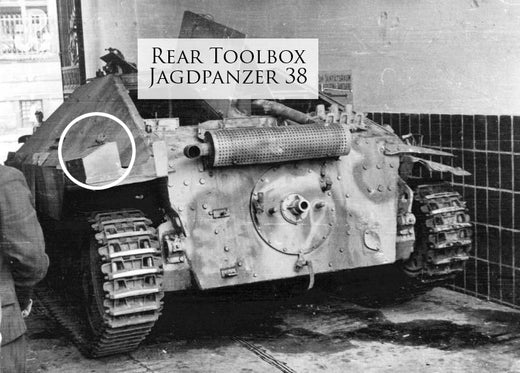This Fine Art Print by Artist Craig Tinder depicts the peak of the German Offensive during the Battle of the Bulge when Panzer Lehr made the fateful turn to Rochefort, Belgium with their remaining Jagdpanzer 38 tank destroyers (Sd.Kfz. 138/2) - informally known as the "Hetzer". This Limited Edition Canvas Print includes a very rare fragment from the rear toolbox lid from a Jagdpanzer 38 serving with the Panzer Lehr Division and destroyed during the Battle of the Bulge.
Details About the RELIC:
In the lead-up to the 23 December 1944 attack on Rochefort, France, during the Battle of the Bulge, Panzer Lehr, one of Germany's elite armored divisions, found itself severely understrength. Only one of its two tank battalions was combat-ready, as the other had been transferred to its parent unit, the 3rd Panzer Division. This diminished fighting force was part of Germany’s last major offensive on the Western Front, an attempt to break through the Allied lines and push back their advances. Despite being a shadow of its former self, Panzer Lehr remained a crucial element in the Ardennes offensive.
 Rear toolbox lid from Hetzer tank - fragments from this are used as relics on "The Turn to Rochefort" limted edition prints
Rear toolbox lid from Hetzer tank - fragments from this are used as relics on "The Turn to Rochefort" limted edition prints
A tangible relic of this desperate final offensive was discovered in the mid-1990s—a rear toolbox lid from a Jagdpanzer 38, a tank destroyer used by Panzer Lehr. Mounted on the left rear quarter of each vehicle, the toolbox lid is a stark reminder of the ferocity and intensity of the fighting in the Ardennes. Having been buried in the soil for decades, the relic shows significant wear, including heavy pitting and rust, effects of the passage of time in the harsh environment of the battlefield.
 Rear toolbox lid from Hetzer tank - fragments from this are used as relics on "The Turn to Rochefort" limted edition prints
Rear toolbox lid from Hetzer tank - fragments from this are used as relics on "The Turn to Rochefort" limted edition prints
Each canvas print in this collection includes a fragment removed from this original toolbox lid, offering a unique connection to the history of Panzer Lehr’s involvement in the Battle of the Bulge. The relic serves as a symbol of Germany’s last significant armored thrust in Western Europe, a battle that marked the beginning of the end for the Third Reich’s war effort.
 Rear toolbox lid from Hetzer tank - fragments from this are used as relics on "The Turn to Rochefort" limted edition prints
Rear toolbox lid from Hetzer tank - fragments from this are used as relics on "The Turn to Rochefort" limted edition prints
 Photo of Hetzer tank showing location of rear toolbox
Photo of Hetzer tank showing location of rear toolbox
 Artist, Craig Tinder, holding Hetzer tank relic that is included in "The Turn to Rochefort" limited edition prints
Artist, Craig Tinder, holding Hetzer tank relic that is included in "The Turn to Rochefort" limited edition prints
The Story Behind the Print:
As the German offensive surged during the Battle of the Bulge, the Panzer Lehr Division, one of Germany's elite armored units, launched an attack on the strategic town of Rochefort, Belgium, on 23 December 1944. Armed with Jagdpanzer 38 (Sd.Kfz. 138/2) tank destroyers, Panzer Lehr pushed forward in what would become a costly and hard-fought engagement. Despite their determined efforts, the division struggled against fierce American resistance. Rochefort, a key objective on the road to the Meuse River, was of vital importance to the German strategy of breaking through the Allied lines.
By nightfall, the town had finally fallen into German hands after the Americans withdrew from the area. However, the victory came at a steep price for Panzer Lehr, which suffered significant losses in both personnel and equipment. The intense battle, coupled with the division's diminished strength, left the unit weakened for further offensive actions.
In the days following the capture of Rochefort, Panzer Lehr encountered even stronger resistance from Allied forces. Lacking the manpower and resources to maintain their momentum, the division was forced to halt its offensive and assume defensive positions. Relegated to defending the town of Remagne near Bastogne, Panzer Lehr found itself stretched to the limit, struggling with critical shortages of fuel, supplies, and reinforcements. Over the following weeks, the once-proud division was gradually worn down by continued Allied counterattacks and logistical challenges, ultimately leading to their retreat.
The Battle of Rochefort, like much of the Ardennes campaign, exemplified the increasingly desperate nature of Germany’s final major offensive on the Western Front, as their once-dominant forces were slowly ground down by the superior logistics and determination of the Allies.
Learn more about A Compact Powerhouse of World War II in the Hetzer Tank? Click Here
To purchase or see similar items, visit here.
Commissioned by Museums, Treasured by Collectors





Share:
Golden Age of Sail, the story behind "Cutty Sark"
Golden Age of Sail, the story behind "Cutty Sark"